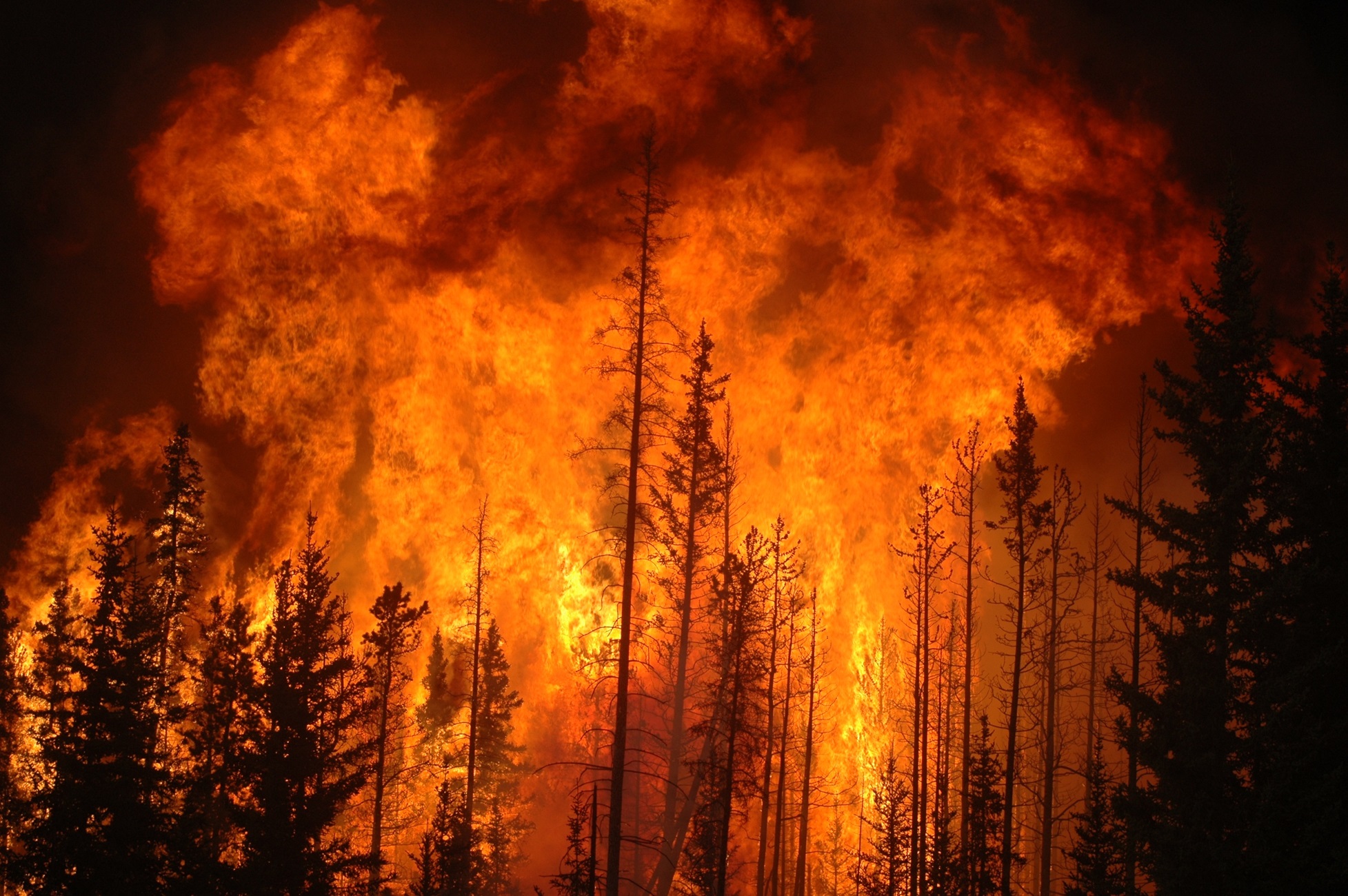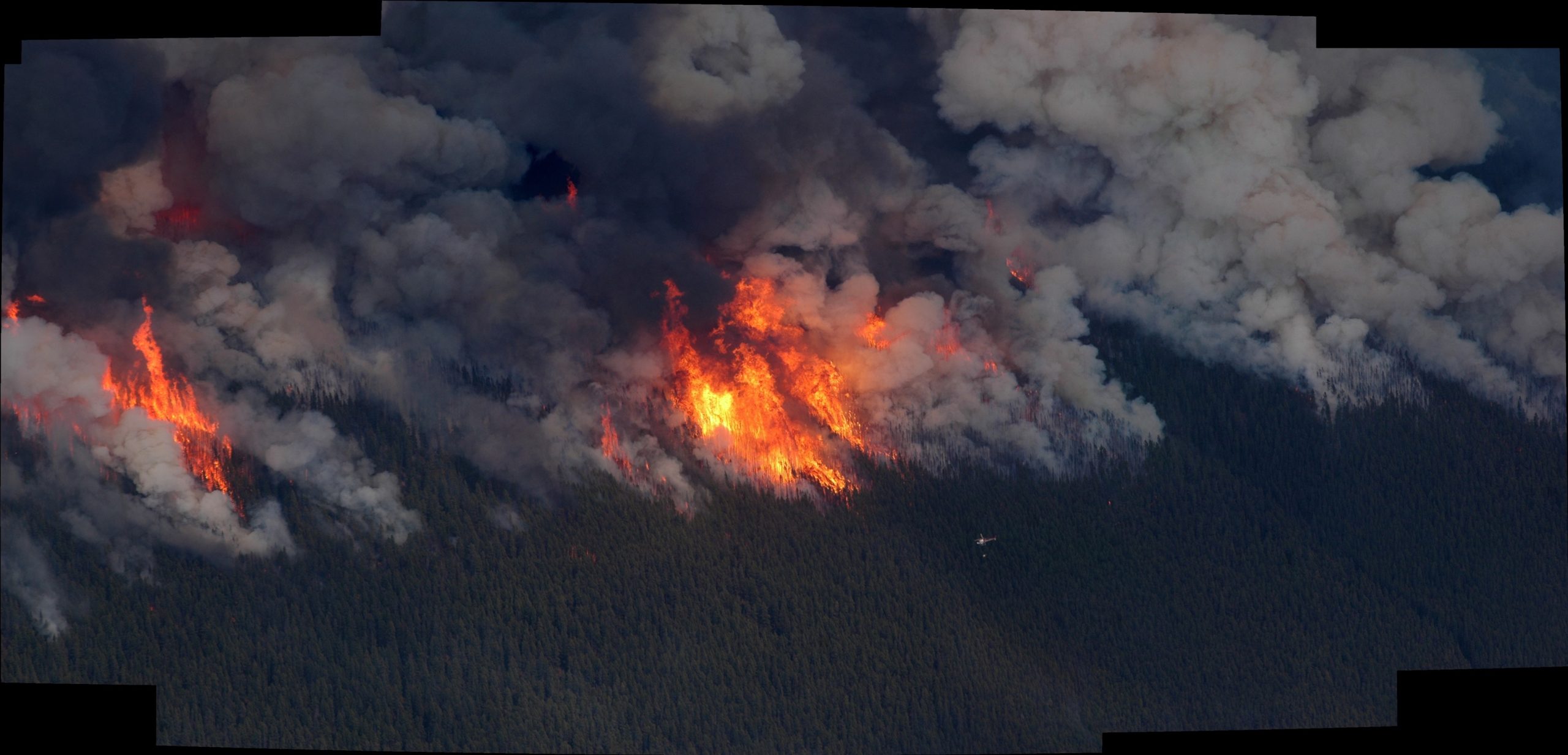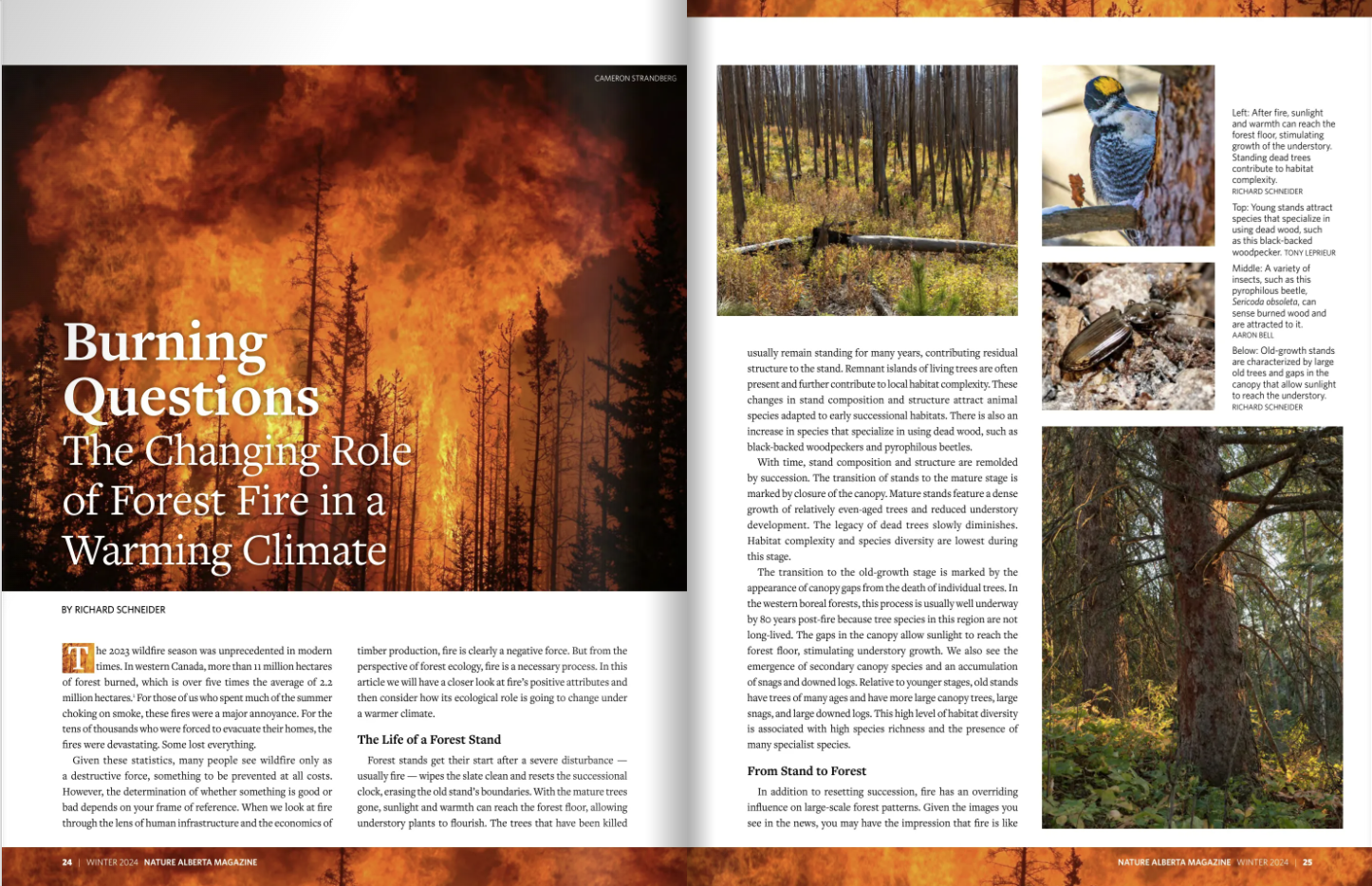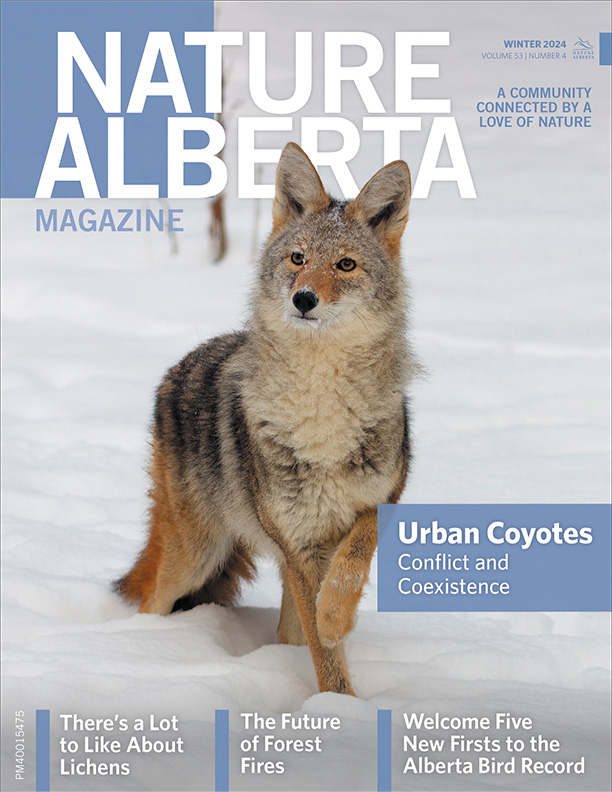The Changing Role of Forest Fire in a Warming Climate
19 January 2024

BY RICHARD SCHNEIDER
The 2023 wildfire season was unprecedented in modern times. In western Canada, more than 11 million hectares of forest burned, which is over five times the average of 2.2 million hectares.1 For those of us who spent much of the summer choking on smoke, these fires were a major annoyance. For the tens of thousands who were forced to evacuate their homes, the fires were devastating. Some lost everything.
Given these statistics, many people see wildfire only as a destructive force, something to be prevented at all cost. However, the determination of whether something is good or bad depends on your frame of reference. When we look at fire through the lens of human infrastructure and the economics of timber production, fire is clearly a negative force. But from the perspective of forest ecology, fire is a positive and necessary process. In this article we will have a closer look at fire’s positive attributes and then consider how its ecological role is going to change under a warmer climate.
The Life of a Forest Stand
Forest stands get their start after a severe disturbance — usually fire — wipes the slate clean and resets the successional clock, erasing the old stand’s boundaries. With the mature trees gone, sunlight and warmth can reach the forest floor, allowing understory plants to flourish. The trees that have been killed usually remain standing for many years, contributing residual structure to the stand. Remnant islands of living trees are often present and further contribute to local habitat complexity. These changes in stand composition and structure attract animal species adapted to early successional habitats. There is also an increase in species that specialize in using dead wood, such as black-backed woodpeckers and pyrophilus beetles.
With time, stand composition and structure are remolded by succession. The transition of stands to the mature stage is marked by closure of the canopy. Mature stands feature a dense growth of relatively even-aged trees and reduced understory development. The legacy of dead trees slowly diminishes. Habitat complexity and species diversity are lowest during this stage.
The transition to the old-growth stage is marked by the appearance of canopy gaps from the death of individual trees. In the western boreal forests, this process is usually well underway by 80 years post-fire because tree species in this region are not long-lived. The gaps in the canopy allow sunlight to reach the forest floor, stimulating understory growth. We also see the emergence of secondary canopy species and an accumulation of snags and downed logs. Relative to younger stages, old stands have trees of many ages and have more large canopy trees, large snags, and large downed logs. This high level of habitat diversity is associated with high species richness and the presence of many specialist species.
From Stand to Forest
In addition to resetting succession, fire has an overriding influence on large-scale forest patterns. Given the images you see in the news, you may have the impression that fire is like an enormous steamroller, flattening everything in its path. In reality, fire behaviour is highly variable. Its intensity and direction are influenced by local topography, weather, wind, and other factors. Stand age and composition also play a role. As a result, burn patterns are highly complex. Some spots may be utterly destroyed, while other areas may experience only low-grade burning of the forest floor. With changes in wind direction, some spots may be entirely skipped over and remain intact.

Fire intensity is highly variable, and shifts in direction are common. This creates complex burn patterns. CAMERON STRANDBERG
Additional complexity arises from variability in the occurrence of fire over time. If you tally the total area burned over the years, you will find that a relatively small number of fires account for most of the burning. For example, of the roughly 35,000 fires recorded in Alberta’s wildfire database since 1980, the 100 largest fires account for 73% of the total area burned.2 These massive fires are generally driven by unusual weather conditions and are all but unstoppable, as we witnessed in 2023. Because they occur sporadically, they leave a noticeable imprint on the age structure of the forest, similar to the way baby boomers create a blip in Canada’s human population.
All this complexity in fire size, distribution, and local behaviour generates complex forest patterns, both at the stand scale and the landscape scale. Forest ecologists describe boreal ecosystems as a “shifting mosaic” of forest stands. The fire-driven variability in forest structure and pattern generates the habitat complexity needed to support a high level of species diversity. The upshot is that, while fire is certainly an agent of destruction, it is also a force of renewal, vital for maintaining forest biodiversity.
What Does the Future Hold?
If you get in your car in Medicine Hat and drive north to Fort McMurray, you will notice that the vegetation becomes progressively taller the farther north you go. Short, hardy grasses transition to taller grasses, which eventually become dotted with aspen stands. Continuing northward, the aspen trees become taller and coalesce into a closed forest. Finally, the forests become a mixture of aspen and coniferous species.
The primary driver of this ecological sequence is ground moisture. It takes more water to grow a spruce tree than a patch of drought-tolerant grass. But wait — the rate of precipitation across most of northern Alberta is no higher than it is in the region between Edmonton and Calgary. So how is it that we find grasslands in the south and boreal forest in the north?
The answer is that ground moisture depends not only on water inputs, but also on water losses, especially from evaporation. The rate of evaporation is much higher on the hot, southern prairie than in cooler northern forests. Thus, we have an ecological gradient that is driven by a moisture gradient that is in turn driven by a temperature gradient. The implication is that the distribution of Alberta’s grasslands, parkland, and boreal forest is ultimately controlled by temperature. And we know that average temperatures are steadily rising.
By this point you might be wondering what this all has to do with fire. We’ll make the connection now. As temperatures continue to rise in coming decades, more and more of Alberta’s boreal region will fall below the moisture threshold needed to sustain a forest ecosystem. The transition to aspen parkland and grassland will not be immediate because mature trees have considerable resilience and can persist in suboptimal conditions. It is the young seedlings that are highly vulnerable and will die in the absence of sufficient moisture. Consequently, forest ecosystem transitions will manifest mainly as regeneration failures following fire or other severe disturbance.3 The implication is that fire will change from an agent of forest renewal to a driver of ecosystem transition.
As the boreal region becomes warmer and drier, the rate of fire will also increase, hastening the transition process. Indeed, it already has. In terms of area burned, five of the ten most destructive years on record (dating back to the 1930s) have occurred since 2011.2 This is no surprise to fire ecologists. Since the 1990s, researchers have been predicting that the rate of wildfire will increase in the western boreal as the climate warms because of a lengthened fire season, increased fire severity, and increased fire frequency.4 We have entered a new normal, and the extreme fire season of 2023 will not be the last of its kind.
How Should We Respond?
Last summer’s fires prompted calls for the government to “Do something!” But what? More and better fire suppression? That’s easier said than done. Alberta and B.C. both spent close to a billion dollars last year fighting fires, and yet the fires raged on. Given last year’s climatic conditions, we likely could have allocated our entire provincial budget to firefighting and still failed to stop the burning. At some point, increased fire and soaring costs will likely cause Alberta to throw in the towel and limit its northern firefighting to the protection of human habitation, the way Saskatchewan does now.
Another idea gaining renewed attention is the FireSmart program.5 This program began as a government initiative to help communities in forested areas learn about and reduce risks from wildfire. It promotes mitigation steps, such as vegetation management and the creation of fire breaks, to keep people safe and minimize the loss of infrastructure.
The basic FireSmart concept, focused on protecting communities, is sound. However, some land managers now want to extend the program to the broader landscape. For example, the B.C. Forest Practices Board recently released a report that says we should decrease tree density and shift the forest to more fire-resistant species and younger age classes in order to boost forest resilience.6 The same ideas are percolating in Alberta. You can see what this looks like in practice by visiting the FireSmart demonstration site adjacent to the Fish Lake Provincial Recreation Area (west of Nordegg). A hiking trail begins at the Fish Lake campground and then winds its way through the new FireSmart landscape.
The coniferous forests in the Fish Lake Recreation Area are very old and exhibit habitat complexity and high biodiversity. Entering the FireSmart landscape is like a gut punch. The landscape is barren, best suited to lawn bowling rather than the maintenance of biodiversity. Interpretive signs along the trail extol the virtues of the FireSmart program and explain how transforming the spruce forest to a less flammable aspen forest will reduce the risk of fire. But more than ten years after the original old-growth forest was logged, the site remains a field of grass littered with a few old stumps. If the site demonstrates anything, it is the folly of ecosystem engineering.
The regeneration failure is disconcerting, but the larger problem is the whole idea of forest conversion. It is directly contrary to Alberta’s commitment to the principles of sustainable forest management, which require forest companies to maintain natural forest structure, patterns, and composition over time. This is the key to maintaining biodiversity in the face of forest harvesting. Creating firebreaks to protect communities is one thing, transforming the entire forest is another.
Some will argue that it doesn’t matter, since it will all transform anyway because of climate change. We might as well log it before it burns. This line of reasoning misses some important points. First, not all forests are going to transition to parkland and grassland. Wetter areas, such as the foothills around Fish Lake, are predicted to remain forested. Second, forests are more than standing timber. Management objectives are much different when you consider the needs of wildlife.
We know that all species have the ability to shift their range in response to climatic changes because they’ve done so during past glacial periods. However, the current episode of climate change is much faster than previous episodes, and many species will struggle to shift their ranges quickly enough. Moreover, many wildlife populations have declined and become fragmented because of industrial use of the forest, and this has seriously diminished their adaptive capacity. Therefore, our management objective should be to slow forest transitions as much as possible, to give species the time they need to shift northwards. This means reducing the rate of logging, especially of old-growth stands, so that fire is the only disturbance that species have to contend with. Hastening forest transitions under the banner of FireSmart is exactly the wrong thing to do.
Of course, the best management action is to address causes of global warming directly, rather than treating the symptoms. The faster we can achieve net-zero in carbon emissions, the less impact there will be in terms of destructive wildfires and ecosystem transitions. It’s too late to forestall all changes; however, through concerted action we can avoid a future that neither wildlife nor humans can accommodate.
In summary, fire has historically been an agent of both destruction and renewal. By resetting the successional clock and creating complex landscape patterns, fire plays a critical role in supporting forest biodiversity. However, as a consequence of climate change, fire has now become an agent of forest ecosystem transition, threatening both wild species and human communities. Trying to prevent these changes through increased fire suppression is like trying to hold back the tide. We instead need to focus on treating the cause by reigning in carbon emissions. Climate mitigation will not be cheap, but as the fire season of 2023 demonstrates, cheap is no longer an option for us.
References
- Canadian Wildland Fire Information System, Weekly Graphs (online). Natural Resources Canada. Downloaded Oct. 2023. Available at: https://cwfis.cfs.nrcan.gc.ca/report/graphs
- Alberta Wildfire Database, Alberta Forestry and Parks. Downloaded Oct. 2023. Available at: https://www.alberta.ca/wildfire-maps-and-data
- Schneider, Richard R. (2013). Alberta’s Natural Subregions Under a Changing Climate: Past, Present, and Future. Available at: https://era.library.ualberta.ca/items/e627b316-e0fb-4765-ba32-81cbea5eee44/view/ed838844-f805-4403-964a-1180b339c67e/Schneider-202013-20--20Subregions-20under-20climate-20change.pdf
- Weber, M. and M. Flannigan (1997). Canadian boreal forest ecosystem structure and function in a changing climate: impact on fire regimes. Environmental Reviews 5:134-166.
- FireSmart Alberta: https://firesmartalberta.ca/
- Forest and Fire Management in BC: Toward Landscape Resilience (2023). B.C. Forest Practices Board.
Richard Schneider is a conservation biologist who has worked on species at risk and land-use planning in Alberta for the past 30 years. A new digital version of his book, Biodiversity Conservation in Canada: From Theory to Practice, is now available from the University of Alberta library, at no cost to the public. Richard is the editor-in-chief of Nature Alberta Magazine.
Read the Original Article for this Post
For a richer reading experience, view this article in the professionally designed online magazine with all images and graphs in place.
This article originally ran in the Winter 2024 issue of Nature Alberta Magazine (Vol. 53 | No. 4).


